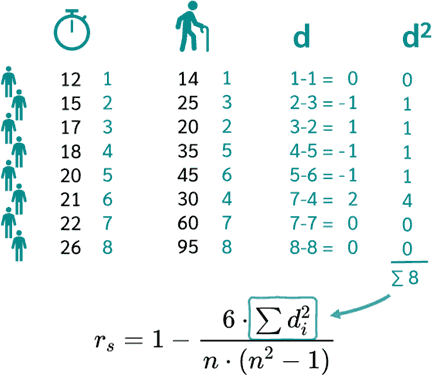Standardized Mean Difference (Cohen's d)
Standardized Mean Difference (Cohen's d)
Cohen's D is a measure of effect size commonly used in statistical hypothesis testing to quantify the magnitude of the difference between two means. It was developed by Jacob Cohen.
Interpretation:
Cohen's D represents the standardized difference between the means of two groups. Positive values indicate that the mean of one group is greater than the mean of the other, while negative values indicate the opposite. The absolute value of D indicates the magnitude of the difference.
Conventional Thresholds:
Cohen proposed the following conventional thresholds for interpreting the magnitude of Cohen's D:
Small effect: D = 0.2
Medium effect: D = 0.5
Large effect: D = 0.8
Assumptions:
The use of Cohen's D assumes that:
The data is normally distributed.
The variances of the two groups being compared are approximately equal.
Calculation:
Cohen's D is calculated as:
D = (μ1 - μ2) / σ
where:
μ1 and μ2 are the means of the two groups
σ is the pooled standard deviation, which represents the variability within both groups
Advantages and Disadvantages:
Advantages:
Easy to understand and interpret
Can be applied to both parametric and non-parametric tests
Provides a standardized measure of effect size, allowing for comparisons across different studies
Disadvantages:
Assumes normality and equal variances
Sensitive to sample size, meaning that larger sample sizes can lead to larger effect sizes
Does not provide information about the statistical significance of the difference
Example:
Suppose you have two groups, Group A and Group B, with the following means and standard deviations:
Group A: μ1 = 50, σ1 = 10
Group B: μ2 = 40, σ2 = 12
Using the formula above, we calculate Cohen's D as:
D = (50 - 40) / ((10^2 + 12^2) / 2)^0.5
D = 10 / 11.18
D ≈ 0.89
This result indicates a large effect size, as the difference between the means of the two groups is standardized to be almost 0.9 standard deviations.
Example 1:
Cohen's d for a Cholesterol-Lowering Agent
Study: A randomized controlled trial comparing a new cholesterol-lowering agent to a placebo.
Participants: 1000 adults with high cholesterol levels.
Intervention: Participants were randomly assigned to receive either the cholesterol-lowering agent (n=500) or a placebo (n=500) for 12 weeks.
Outcome: Change in cholesterol levels from baseline to 12 weeks.
Results:
The mean change in cholesterol levels in the cholesterol-lowering agent group was -30 mg/dL.
The mean change in cholesterol levels in the placebo group was -10 mg/dL.
The standard deviation of the change in cholesterol levels was 20 mg/dL in both groups.
Cohen's d:
Cohen's d is a measure of effect size that compares the means of two groups. It is calculated as the difference between the two means divided by the standard deviation of the pooled sample.
Cohen's d = (M1 - M2) / Sp
where:
M1 is the mean of the cholesterol-lowering agent group
M2 is the mean of the placebo group
Sp is the pooled standard deviation
Cohen's d = (-30 - (-10)) / 20 = -1.0
Interpretation:
A Cohen's d of -1.0 indicates a large effect size. This means that the cholesterol-lowering agent significantly reduces cholesterol levels compared to placebo.
Example 2:
Study Design:
A randomized clinical trial comparing a new glucose-lowering agent (Drug X) to a standard agent (Control) in patients with type 2 diabetes.
Sample Size:
100 patients in each treatment group.
Outcome:
Change in HbA1c level from baseline to 12 weeks.
Results:
Drug X group: Mean HbA1c change = -0.9%
Control group: Mean HbA1c change = -0.5%
Statistical Analysis:
Cohen's d = (Mean1 - Mean2) / Pooled Standard Deviation
Pooled Standard Deviation = sqrt(((SD1^2 + SD2^2) / 2)
SD1 (Drug X) = 0.2%
SD2 (Control) = 0.1%
Cohen's d Calculation:
Cohen's d = (-0.9 - (-0.5)) / sqrt(((0.2^2 + 0.1^2) / 2)
Cohen's d = -0.4 / 0.14
Cohen's d = -2.86
Interpretation:
Cohen's d of -2.86 indicates a large effect size. The new glucose-lowering agent (Drug X) resulted in a significantly greater reduction in HbA1c compared to the standard agent, with a magnitude of effect that is considered substantial in clinical terms.
......................................................................................................
👉 For the data analysis, please go to my Youtube(Ads) channel to Watch Video (Video Link) in
Youtube Channel (Channel Link) and Download(Ads) video.
💗 Thanks to Subscribe(channel) and Click(channel) on bell 🔔 to get more videos!💗!!
- Tell: (+855) - 96 810 0024
- Telegram: https://t.me/sokchea_yann
- Facebook Page: https://www.facebook.com/CambodiaBiostatistics/
- TikTok: https://www.tiktok.com/@sokcheayann999
- STATA for dataset restructuring, descriptive and analytical data analysis
- SPSS for dataset restructuring, data entry, data check, descriptive, and analytical data analysis
- Epi-Info for building questionnaires, data check, data entry, descriptive, and analytical data analysis
- Epidata-Analysis for dataset restructuring, descriptive and analytical data analysis
- Epi-Collect for building questionnaires, remote data entry, mapping, and data visualization
- Epidata-Entry for building questionnaires, data check, data entry, and data validation
ABA Account-holder name: Sokchea YAN
ABA Account number: 002 996 999
ABA QR Code:
or tap on link below to send payment:
https://pay.ababank.com/iT3dMbNKCJhp7Hgz6
✌ Have a nice day!!! 💞












Comments
Post a Comment